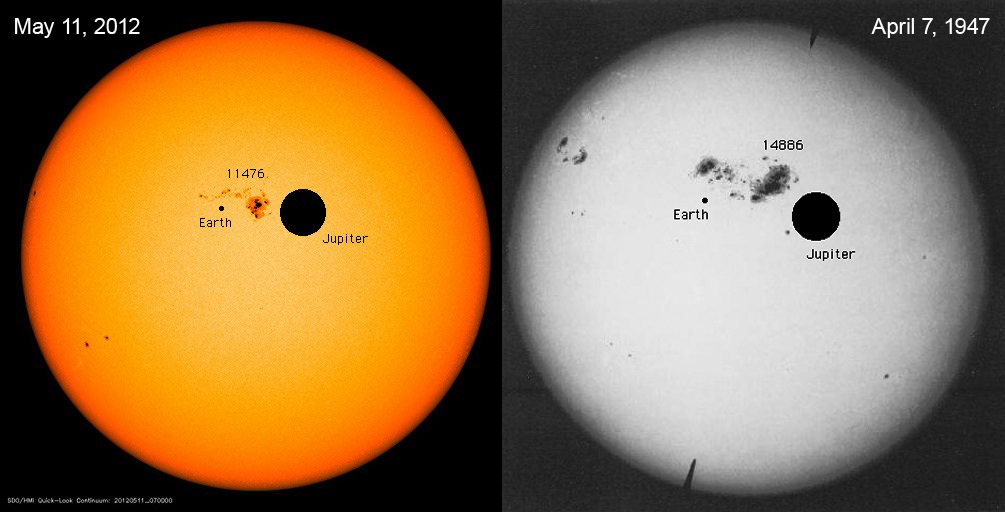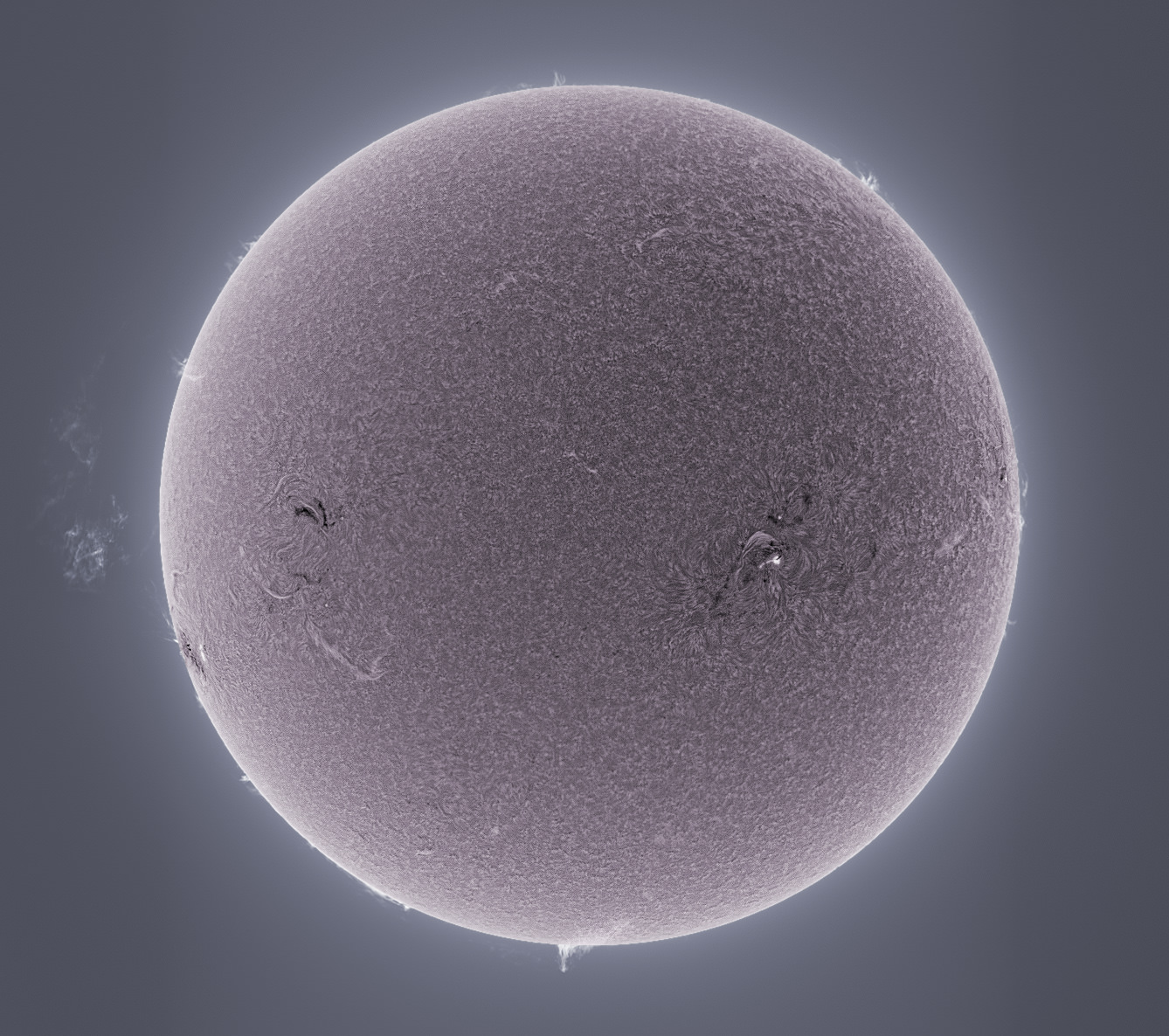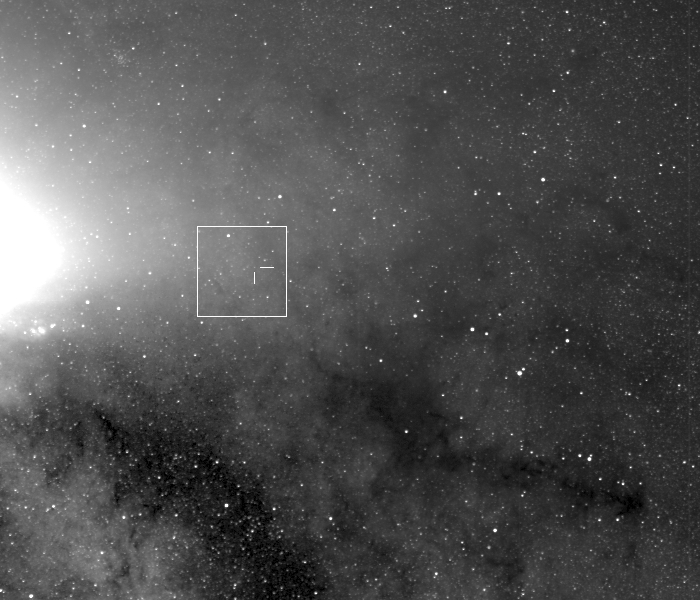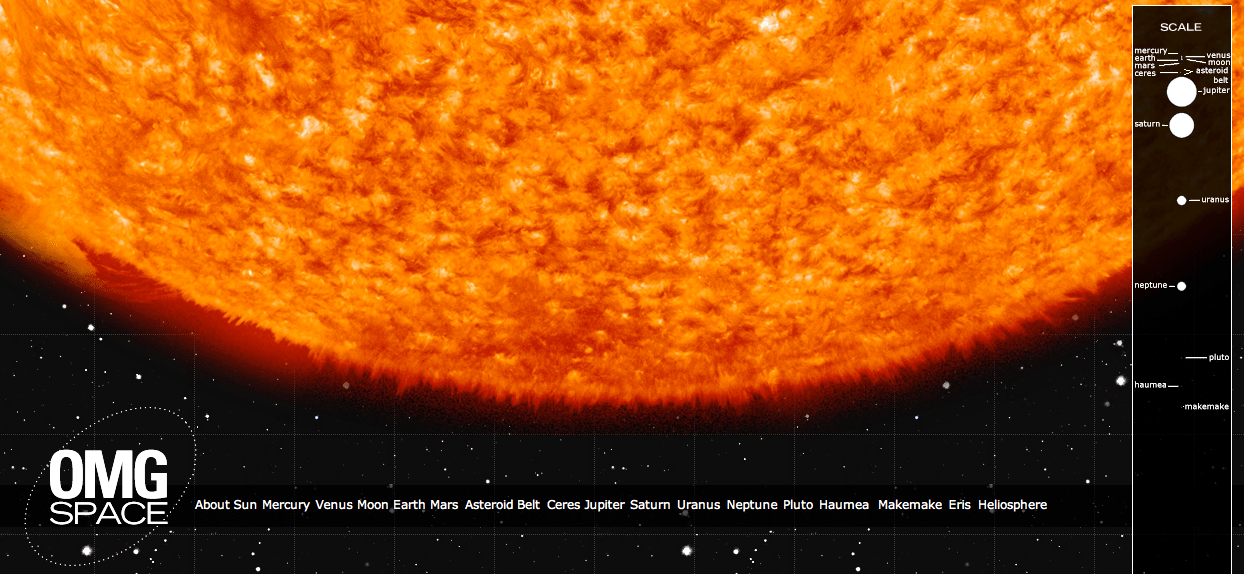This great video created from images taken by the Solar and Heliospheric Observatory (SOHO) on May 13 and 14 show Jupiter as it comes close to the Sun (from our vantage point) in a solar conjunction. But what it really looks like is the old “Space Invaders” video game, with Jupiter marching across the screen. There’s even a couple of sungrazing comets “pewpew-ing” in like the laser cannon shots in the game, and a coronal mass ejection completes the scene as an explosion (which is actually more like “Asteroids.”) For more fun, the team who created this video at the Naval Research Laboratory’s Sungrazing Comets website takes the time to show all the different objects in the scene, which amazingly includes Callisto and Ganymede, two of Jupiter’s moons. All it needs is the funky video game background music.
Continue reading “Watch Jupiter as a ‘Space Invader’”
How Big Are Sunspots?
[/caption]
The short answer? Really big. The long answer? Really, really big.
The image above shows sunspot regions in comparison with the sizes of Earth and Jupiter, demonstrating the sheer enormity of these solar features.
Sunspots are regions where the Sun’s internal magnetic fields rise up through its surface layers, preventing convection from taking place and creating cooler, optically darker areas. They often occur in pairs or clusters, with individual spots corresponding to the opposite polar ends of magnetic lines.
(Read “What Are Sunspots?”)
The image on the left was acquired by NASA’s Solar Dynamics Observatory on May 11, 2012, showing Active Region 11476. The one on the right comes courtesy of the Carnegie Institution of Washington, and shows the largest sunspot ever captured on film, AR 14886. It was nearly the diameter of Jupiter — 88,846 miles (142,984 km)!
“The largest sunspots tend to occur after solar maximum and the larger sunspots tend to last longer as well,” writes SDO project scientist Dean Pesnell on the SDO is GO blog. “As we move through solar maximum in the northern hemisphere and look to the south to pick up the slack there should be plenty of sunspots to watch rotate by SDO.”
Sunspots are associated with solar flares and CMEs, which can send solar storms our way and negatively affect satellite operation and impact communications and sensitive electronics here on Earth. As we approach the peak of the current solar maximum cycle, it’s important to keep an eye — or a Solar Dynamics Observatory! — on the increasing activity of our home star.
(Image credit: NASA/SDO and the Carnegie Institution)
Ring of Fire! Annular Solar Eclipse on May 20

[/caption]
There’s a great reason to look up this weekend and hope for clear skies! On May 20-21 an annular eclipse of the Sun will be visible from a 300 kilometer-wide track that crosses eastern Asia, the northern Pacific Ocean and the western United States. An annular eclipse means the Moon will not cover the Sun completely, and so when the Moon is directly in front of the Sun, there will be a bright ring of visible light on the surrounding edges, creating a so-called ‘ring of fire.’ The eclipse begins at 20:56 UTC (16:56 EDT US time) on May 20, and ends at 02:49 UTC May 21 (22:49 on May 20 EDT).
Not in that swath? See the map below, but you may be able to see a partial eclipse if you are in Asia, the Pacific and the western two-thirds of North America.

Still not in the path of the Sun during that time? There will be several webcasts, including one from SLOOH, and more from Hong Kong, the summit of Mt. Fuji in Japan, and Area 51 in Nevada USA (no alien spaceships will be seen in this webcast, guaranteed.)
An important note if you ARE in an area where you can see the eclipse. DO NOT look directly at the Sun, and especially do not look through a telescope or binoculars at the Sun with your eyes directly. That ‘ring of fire’ will indeed burn, burn, burn your retinas, and could cause serious and permanent eye damage. There are special eclipse glasses, or you can make your own eclipse viewers. Mr. Eclipse has a whole list with instructions for pinhole cameras, and other safe viewing methods. If you have a telescope, the folks from Galileoscope have instructions for how to build a Sun-funnel for safe viewing
We posted an article last week about special eclipse glasses you can purchase, but you might be running out of time to buy them.
If you take any images of the eclipse (again, know what you are doing and be careful!) please share them with us via our Flickr page, or send them in via email. We’ll have a grand eclipse gallery of images from around the world!
Some of the spacecraft will also be observing the eclipse and will provide images and movies, such as the JAXA/NASA Hinode mission. You will be able to see the images and videos here, and as an added bonus Hinode’s X-ray Telescope will be able to provide images of the peaks and valleys of the lunar surface.
Unfortunately, the orbits the Solar Dynamics Observatory (SDO), the Solar Terrestrial Relations Observatory (STEREO), and the Solar Heliospheric Observatory (SOHO) will not provide them with a view of the eclipse.
You can see more eclipse information from Sky and Telescope, NASA and TimeandDate.com
The next solar eclipse will be the total solar eclipse on November 13, 2012.
Here’s a video from NASA:
Big Sunspot; Little Chinese Space Station
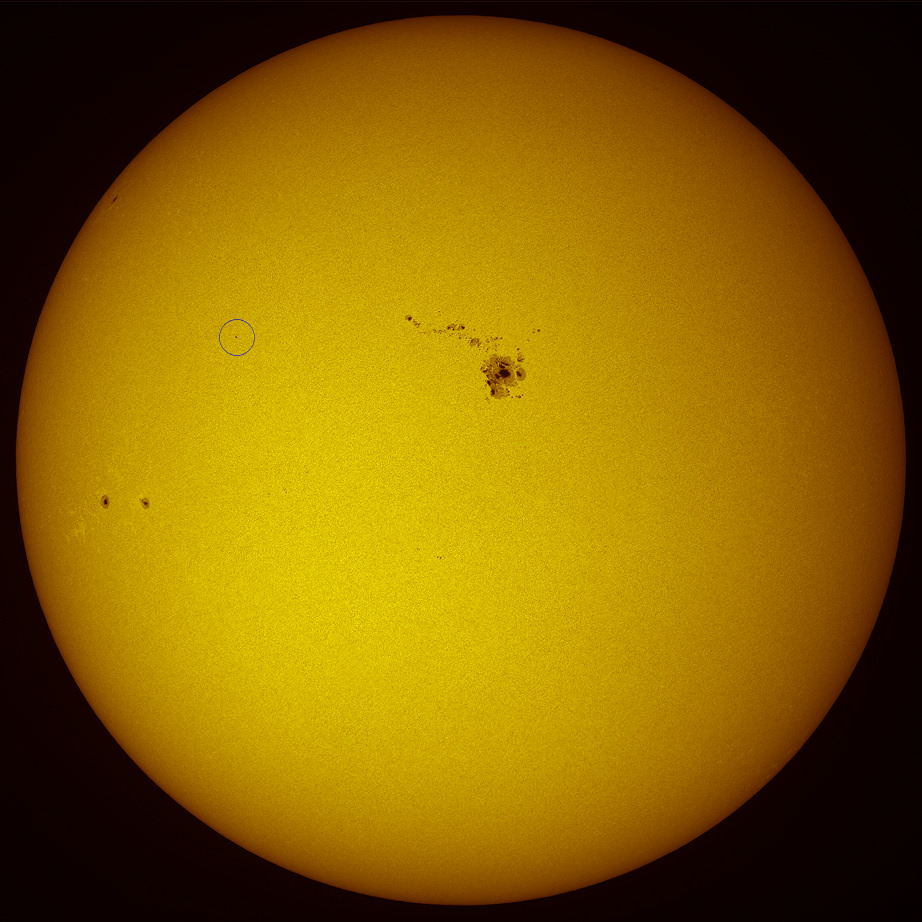
[/caption]
Astrophotographer extraordinaire Thierry Legault has made a name for himself with his images of spacecraft transiting across the face of the Sun. He has done it again by capturing the first-ever image of the Tiangong-1 space station transiting the Sun. The monster sunspot, AR 1476 absolutely dwarfs the Chinese space station (inside the circle), but you can see incredible details of the Tiangong-1 below in a zoomed-in version. Legault had less than a second to capture the event, with the Tiangong traveling at 7.4km/s (26500 km/h or 16500 mph,) the transit duration was only 0.9 seconds! The size of the station is pretty small — as without solar panels the first module of the Tiangong measures just 10.3 x 3.3 meters.
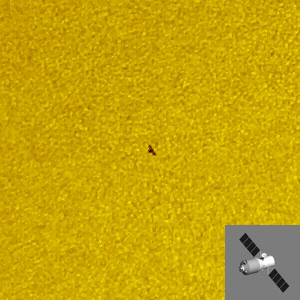
Legault’s equipment was a Takahashi FSQ-106 refractor, a Baader Herschel prism and Canon 5D Mark II camera. Exposure of 1/8000s at 100 ISO.
As Legault told us in an interview earlier this year, in order to capture such images he studies maps, uses CalSky software, and has a radio synchronized watch to know very accurately when the transit event will happen.
“My camera has a continuous shuttering for 4 seconds, so I begin the sequence 2 seconds before the calculated time,” he said. “I don’t look through the camera – I never see the space station when it appears, I am just looking at my watch!”
For a transit event, he gets a total of 16 images – 4 images every second, and only after he enlarges the images will he know if he succeeded or not.
“There is a kind of feeling that is short and intense — an adrenaline rush!” Legault said. “I suppose it is much like participating in a sport, but the feeling is addictive.”
Thanks to Thierry for sharing his latest success, and you can see larger versions of these images, and much more at his website.
Super Moon? How About a Super Sun!
[/caption]
On May 5, 2012, while everyone else was waiting for the “Super Moon” astrophotographer Alan Friedman was out capturing this super image of a super Sun from his back yard in Buffalo, NY!
Taken with a specialized telescope that can image the Sun in hydrogen alpha light, Alan’s photo shows the intricate detail of our home star’s chromosphere — the layer just above its “surface”, or photosphere.
Prominences can be seen rising up from the Sun’s limb in several places, and long filaments — magnetically-suspended lines of plasma — arch across its face. The “fuzzy” texture is caused by smaller features called spicules and fibrils, which are short-lived spikes of magnetic fields that rapidly rise up from the surface of the Sun.
On the left side it appears that a prominence may have had just detached from the Sun’s limb, as there’s a faint cloud of material suspended there.
Alan masterfully captures the Sun’s finer details in his images on a fairly regular basis… see more of his solar (and lunar, and… vintage headwear) photography on his blog site here.
Image © Alan Friedman. All rights reserved.
NASA’s STEREO Spots a New Nova
While on duty observing the Sun from its position in solar orbit, NASA’s STEREO-B spacecraft captured the sudden appearance of a distant bright object. This flare-up turned out to be a nova — designated Sagittarii 2012 — the violent expulsion of material and radiation from a re-igniting white dwarf star.
Unlike a supernova, which is the cataclysmic collapse and explosion of a massive star whose core has finally fused its last, a nova is the result of material falling onto the surface of a white dwarf that’s part of a binary pair. The material, typically hydrogen and helium gas, is drawn off the white dwarf’s partner which has expanded into a red giant.
Eventually the white dwarf cannot contain all of the material that it has sucked in from its neighbor… material which has been heated to tremendous temperatures on its surface as it got compressed further and further by the white dwarf’s incredibly strong gravity. Fusion occurs on the dwarf’s outermost layers, blasting its surface out into space in an explosion of light and energy.
This is a nova — so called because, when witnessed in the night sky, one could suddenly appear as a “new star” in the heavens — sometimes even outshining all other visible stars!
An individual nova will soon fade, but a white dwarf can produce many such flares over time. It all depends on how rapidly it’s accreting material (and how much there is available.)
Over the course of 4 days, Sagittarii 2012 reached a magnitude of about 8.5… still too dim to be seen with the unaided eye, but STEREO-B was able to detect it with its SECCHI (Sun Earth Connection Coronal and Heliospheric Investigation) instrument, which is sensitive to extreme ultraviolet wavelengths.
The video above was made from images acquired from April 20 – 24, 2012.
It’s not known yet how far away Sagittarii 2012 is but rest assured it poses no threat to Earth. The energy expelled by a nova is nowhere near that of a supernova, and although you wouldn’t want to have a front-row seat to such an event we’re well away from the danger zone.
What this does show is that STEREO-B is not only a super Sun-watching sentinel, but also very good at observing much more distant stars as well!
Thanks to @SungrazerComets for the heads-up on this novel nova!
[/caption]
OMG Space
[/caption]
“You may think it’s a long way down the road to the chemist’s, but that’s just peanuts to space.” – Douglas Adams
Standard classroom models and textbook illustrations of the Solar System, regardless of how pretty they are, all share one thing in common: they’re wrong. Ok, maybe not wrong, but definitely inaccurate… especially in regards to scale. And understandably so, as it’s nearly impossible to portray in a convenient manner the sheer amount of space there is between the planets and their relative sizes. Even if a model manages to show one or the other in a straightforward, linear fashion, it usually doesn’t show both.
This one does.
OMG Space is a web page made by Margot Trudell as graphic design thesis project at Toronto’s OCAD University. Displayed on the Visual.ly portfolio site, Margot’s expansive infographic shows the Sun, planets and some minor bodies to scale, both in terms of relative size and distance. By clicking on a planet’s name at the bottom of the page you’ll be whisked away toward it, giving a sense of how very far it really is between the many worlds that make up our own little Solar System.
And if that’s not enough, Margot has included a descriptive chart for each world that gives basic information on distance from the Sun, orbital period and moon count as well as details on visiting exploration missions — past, present and planned. These can be accessed by clicking on the respective worlds once you arrive.
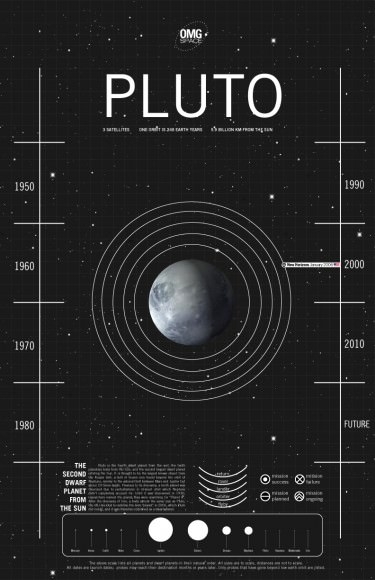
“I created the infographics first and as I worked on them decided they needed more context, and the idea of creating a to scale version of our solar system came to mind,” Margot told Universe Today. “The project was initially intended to be all print, but knowing the real scale of our solar system I eventually came up with the idea of using the infiniteness of the web to my advantage.”
If you watch the scroll bar on the right side of the page (and I do suggest resizing the page to fill your screen as much as possible) you’ll also get a sense of how much space you’re traversing as you zip between worlds. And that’s just taking into consideration the average distances between each planet at opposition. In reality, they’re never lined up in a row like that!
If you’re so inclined you can also scroll up and down manually… if only to see how long it takes you to not get anywhere.
“My favourite thing to do on OMG Space’s website is go to Earth and then click on the link to the Moon,” Margot said. “The small distance you move yet the big gap you see… it gives you a whole new perspective on how far people traveled to get to the moon and back, and it shows how far the moon really is from Earth (I feel that it’s always portrayed as being almost right beside us) and makes you consider how powerful those rockets must have been to get us that far.
“It gives you a bit of that ‘OMG’ feeling that the project is named for.”
Yes, OMG indeed.
Infographics by Margot Trudell. See more of Margot’s work here.
Question About Space Weather? NASA Scientists Have Answers
What’s the difference between a solar flare and a coronal mass ejection? What causes such energetic space events? Worried that the current solar cycle could harm our planet? Here’s part one of a two-part series of common questions people have about the Sun, space weather, and how they affect the Earth. (Part 2 will come out tomorrow.)
There’s also a great webpage from Goddard Space Flight Center that provides video answer to 25 questions on this this topic, such as “could a CME strip off the Earth’s magnetic field?” Check them all out!
How Big Was Monday’s CME?

This big! The M1.7-class flare that erupted from active region 1461 on Monday, April 16 let loose an enormous coronal mass ejection many, many times the size of Earth, making this particular writer very happy that our planet was safely tucked out of aim at the time… and 93 million miles away.
The image above was obtained by NASA’s Solar Dynamics Observatory’s AIA 304 imaging instrument on Monday during the height of the event. I rotated the disk of the Sun 90 degrees to get a landscape look over the eastern limb, cropped it down and then added an Earth image to scale — just to show how fantastically huge our home star really is.
(Read “Watch it Rain on the Sun”)
Some minor editing was done to increase contrast and heighten detail in the eruption.
The CME was not directed our way, but it was aimed at NASA’s STEREO-B spacecraft, which will encounter the ejected material full-on.
Read more about this event in a previous Universe Today post here, and check out hi-def videos of the CME from SDO here.
Image credit: NASA/SDO and the AIA science team. Edited by Jason Major.
Watch it Rain on the Sun
The big solar flare and coronal mass ejection earlier this week created an unusual event on the Sun: it rained. Not water drops of course, but coronal rain. After the eruption, blobs of plasma fell back to the surface of the Sun, sometimes making ‘splashes’ where they hit. Coronal rain is plasma gas that condenses in the corona and then descends back to the surface. It has long been a mystery and its motion has perplexed solar physicists. For some reason, coronal rain falls much slower than is expected for plasma falling due to the huge gravitational pull of the Sun. Many times, rather than falling straight down — as it would if gravity was the only force pulling on it — the plasma rain follows invisible magnetic field lines, which can be detected by instruments on board watchful spacecraft.
This video was produced from data from the Solar Optical Telescope on NASA/JAXA’s Hinode spacecraft of the big M1/7 class flare that erupted on April 16 from Active Region 1461. Scientists say thanks to spacecraft like Hinode and the Solar Dynamic Observatory, this phenomenon can be studied in much more detail so that they can better understand this unusual event.

